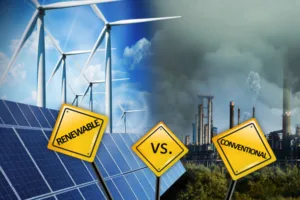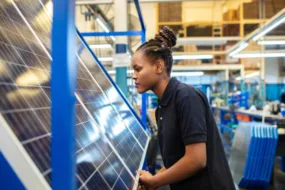Natural gas:

Natural gas has long been touted as a cleaner alternative to coal for electricity generation. However, the tides are turning. Renewable energy sources like solar and wind are becoming increasingly cost-competitive, environmentally friendly, and efficient.
A Simple Breakdown of Natural Gas and Renewable Energy
1. Natural Gas:
i. Fossil fuel has been formed from decomposed organic matter over millions of years.
ii. It’s considered “cleaner” than coal for electricity generation but still emits greenhouse gases.
iii. Its limited resources mean that supplies will eventually run out.
2. Renewable Energy:
i. Its energy is derived from natural sources that are constantly replenished, like sunlight, wind, water, etc.
ii. It produces little to no greenhouse gases during operation.
iii. It is considered a more sustainable solution for long-term energy needs.
Read More: Unveiling the Truth About Natural Gas Greenwashing
Factors that Make Natural Gas an Unattractive Option for Our Energy Needs

The reason for this shift is due to several factors that make natural gas an unattractive option for our energy needs in the future.
1. The Cost Equation: Renewables Are Winning
Renewable energy costs have dramatically decreased. According to the International Renewable Energy Agency (IRENA), the cost of solar power has fallen by 85% since 2010, while wind energy costs have dropped by 60% during the same period. These dramatic reductions are due to technological advancements, economies of scale, and increased competition in the renewable energy sector.
In contrast, the price of natural gas fluctuates with the global market. Geopolitical instability and supply chain disruptions can cause natural gas prices to spike, creating uncertainty for consumers and businesses. Renewables, on the other hand, offer a more stable and predictable cost structure.
2. Environmental Benefits: Renewables are the cleaner choice.
Natural gas is often touted as a “clean-burning” fossil fuel. However, it is still a significant source of greenhouse gas emissions, contributing to climate change. Methane, the main component of natural gas, is a particularly potent greenhouse gas, with over 80 times the warming power of carbon dioxide over 20 years.
Renewable energy sources, on the other hand, produce little to no greenhouse gas emissions during operation. Solar and wind power plants generate electricity without releasing pollutants into the atmosphere, making them a critical part of the fight against climate change.
3. Sustainability: Renewables are a Long-Term Solution
As time goes on, natural gas stocks will run out, but renewable resources like wind and sunlight will always be there to fill the gap. This makes them a more sustainable option for long-term energy security.
Furthermore, solar and wind power plants have a much smaller environmental footprint than natural gas infrastructure. Natural gas extraction can lead to water contamination and habitat destruction, while pipelines pose a safety risk and can leak methane into the atmosphere. Renewable energy sources have minimal impact on land use and wildlife.
4. Innovation and Efficiency: Renewables Are Constantly Improving
The technology behind renewable energy is constantly evolving. Solar panels are becoming more efficient at converting sunlight into electricity, while wind turbines are getting larger and more powerful. These advancements are further driving down the cost of renewable energy, making it an even more attractive option.
Natural gas technology, on the other hand, is relatively mature. While there may be some efficiency gains to be made, there is no significant breakthrough expected that would revolutionise the industry.
5. Public perception: Renewables are the future.
Consumers are increasingly concerned about the environmental impact of their energy choices. Renewable energy sources are becoming more popular as people look for ways to reduce their carbon footprint. Governments around the world are also setting ambitious targets for renewable energy deployment, further accelerating the transition away from fossil fuels.
Natural gas may still play a role in the energy mix for the foreseeable future, particularly in applications where renewables are not yet a viable option. However, the long-term trend is clear: renewable energy is the future of clean, sustainable, and affordable power generation.
6. Renewables’ Social and Economic Benefits
The shift towards renewable energy is not just about the environment; it’s about creating a more sustainable and equitable future. Renewable energy projects often create local jobs in manufacturing, installation, and maintenance. This can boost local economies and empower communities.
Furthermore, renewables can provide energy independence for countries that rely on imported fossil fuels. By harnessing their own solar, wind, or geothermal resources, nations can reduce their dependence on foreign oil and gas, leading to greater energy security.
Read More: Discover the Difference Between Biofuels and Biodiesel
Why Renewables Will Power the Future

Renewable energy sources are not only environmentally friendly, but they are also becoming increasingly reliable. Advancements in battery storage technology allow us to store excess renewable energy generated during peak production times, making it available when needed.
Solar and wind power are also becoming more versatile. Solar panels can now be integrated into buildings, and wind turbines can be deployed in offshore locations with stronger, more consistent winds. This adaptability makes renewables a powerful solution for a wider range of energy needs.
The Role of Natural Gas in the Green Energy Future
Natural gas may still have a role to play in the energy transition, particularly as a backup power source when renewable energy production is low. However, its role will likely diminish as renewable energy technologies continue to develop and become even more cost-competitive.
The future of energy is clean, sustainable, and renewable. By embracing solar, wind, and other renewable sources, we can create a healthier planet, ensure a reliable energy supply, and build a more prosperous future for all.
Read More: How to Earn a Living with Biofuel Development
Conclusion
The writing is on the wall: renewable energy is the future. Natural gas may have been a first step, but cleaner, more sustainable, and cheaper renewable energy sources are now taking their place.
The transition to a renewable-powered future is not only inevitable, but it’s also essential for ensuring a livable planet for generations to come.










